长江口及邻近海域溶解态锰的分布及影响因素*
杨亭亭,任景玲*,王召伟,张许州,张瑞峰
(1. 中国海洋大学,山东 青岛 266100;2. 海洋化学理论与工程技术教育部重点实验室,山东 青岛 266100;3. 华东师范大学,上海 200062;4. 河口海岸学国家重点实验室,上海 200062)
长江口及邻近海域溶解态锰的分布及影响因素*
杨亭亭1,2,任景玲1,2*,王召伟1,2,张许州1,2,张瑞峰3,4
(1. 中国海洋大学,山东 青岛 266100;2. 海洋化学理论与工程技术教育部重点实验室,山东 青岛 266100;3. 华东师范大学,上海 200062;4. 河口海岸学国家重点实验室,上海 200062)
摘要:为研究陆架边缘海锰的生物地球化学循环,利用隐色孔雀绿-高碘酸钠催化动力学方法,对2012-03和2012-07长江口及其邻近海域调查航次采样的溶解态锰浓度进行测定。2012-03长江口及其邻近海域表、底层水体中溶解态锰浓度没有显著性差异。2012-07底层溶解态锰浓度显著高于表层。溶解态锰浓度存在显著的季节差异,2012-07平均浓度显著高于2012-03的。春、夏季溶解态锰浓度在表、底层分布整体上均呈现出由近岸到外海逐渐降低的特征,表明近岸受到河流输入的影响。2012-03长江口及其邻近海域溶解态锰基本表现为保守混合,2012-07盐度2~8海域表层发生明显的清除。两端元混合模型及相关性分析表明,该海域悬浮颗粒物(SPM)是溶解态锰的一个主要汇。此外,水团的物理混合是影响该海域溶解态锰分布的主要因素。
关键词:长江口及邻近海域;溶解态锰;分布特征;季节变化;影响因素
锰在自然界中广泛存在于土壤、岩石、水体和沉积物中,它在地壳中的质量分数为0.071 6%,是排名第12位的金属元素[1]。天然水体中锰的来源主要包括河流输入、大气沉降、海底沉积物的释放、光化学还原过程等[2-3]。由于其风化产物在海水中的溶解度低且存留时间较短,所以在开阔大洋中的浓度≤5 nmol·L-1[4]。受陆源输入等因素的影响,溶解态锰基本表现为近岸高、外海低的分布特征。由于河口区水动力和物理化学条件的不同,溶解态锰在河口混合过程中的行为有较大的差异,表现为保守混合[5-6]、河口中部出现极大值[7-9]或在河海混合初期发生清除[10]等。
锰是浮游植物生长必需的痕量营养元素之一,是叶绿素合成和自由基清除酶促反应中的重要辅助因子[11]。水体中的大型藻类通过生物积累、光合作用及生物矿化等过程,与周围环境的元素相互作用,驱动着C,N,P,Mn等元素在水体内部的转化[12]。锰的生物地球化学循环过程与全球碳、氮的循环紧密相联并直接或间接影响其他微量营养元素的生物地球化学循环,这种作用在陆架边缘海海区显得尤为明显[13],故锰常用来示踪不同陆源输入和水团混合的影响。由于锰在海洋生物地球化学循环中有极其重要的作用,目前已成为国际海洋科学计划“痕量元素及其同位素的海洋生物地球化学研究(GEOTRACES)”(http:∥www.geotraces.org)规定的关键参数之一。
海水中溶解态锰的生物地球化学行为的大量调查研究,主要集中在大洋中锰的分布、输送通量、存留时间、水体及沉积物中锰的赋存形态、迁移转化等方面[14-17]。我国科研人员对锰的海洋生物地球化学研究起步较晚,早期研究主要集中在沉积物和悬浮颗粒物的地球化学组成特征方面,并利用其地球化学组成特征对河流、河口及陆架边缘海沉积物及悬浮颗粒物进行物源分析[18-20],有关我国陆架边缘海区域锰的海洋生物地球化学研究则较少[13],尤其是河口区域溶解态锰的迁移转化规律、水团混合与悬浮颗粒物对锰分布的影响认识不足。我们分析2012-03(春季)和2012-07(夏季)长江口及其邻近海域溶解态锰的时空分布、季节变化,初步探讨影响溶解态锰分布的主要因素,为陆架边缘海域锰的生物地球化学循环的研究提供相关数据支撑。
1材料与方法
1.1站位设置及样品采集
2012-03-06—14分别搭乘“海监46”船和“海监49”船,2012-7-14—18搭乘“海监47”船,对长江口及其邻近海域进行大面调查,调查区域为(120°30′~124°30′ E,29°00′~33°00′ N)站位分布见图1(部分未列出站位为非溶解态锰站位)。
现场用5 L采水器(美国General Oceanics公司Niskin型)采集各个层次的海水,2012-03航次的15个站位使用华东师范大学张瑞峰老师提供的飞鱼采水器[21]采集表层无沾污水样。采水器、采样瓶和样品瓶等在使用前均先用HCl处理,而后进行严格清洗以避免沾污的影响[22-23]。温度、盐度和溶解氧等水文参数由CTD(美国Sea-bird Electronics公司SBE-25型)携带的探头现场测定,悬浮颗粒物(SPM)质量浓度用过滤前后烘干滤膜的质量差值计算。
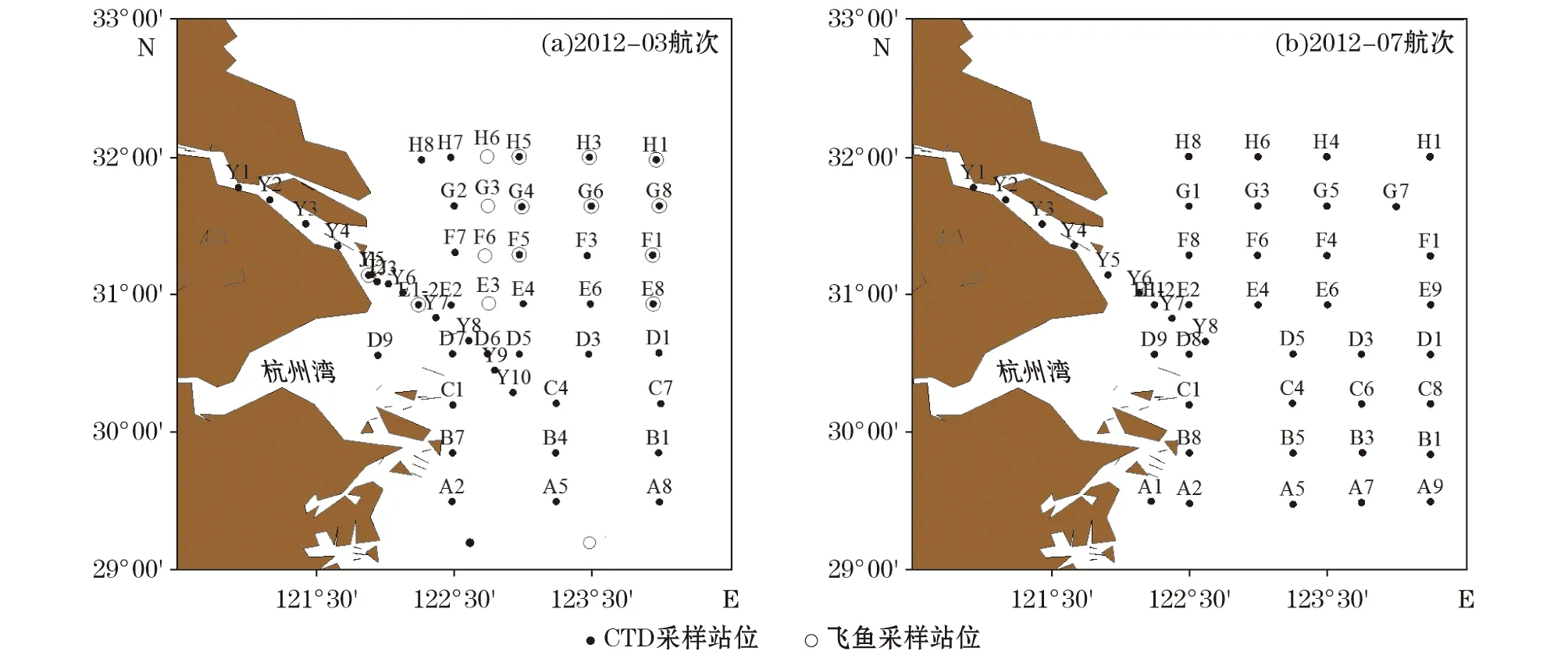
图1 长江口及其邻近海域采样站位图Fig.1 Sampling locations in the Changjiang Estuary and its adjacent area
1.2样品处理
样品采集后立即在现场过滤。用酸处理过的Nalgene滤器和0.45 μm的醋酸纤维膜(pH=2的HCl浸泡24 h,Milli-Q水洗至中性)过滤,按国际GEOTRACES样品采集及保存手册[24],过滤后的样品装于洁净的250 mL Nalgene低密度聚乙烯瓶中,-20 ℃冷冻保存。空白为同样条件下过滤的Milli-Q水,用同样的方法保存。测定时先在室温条件下对冷冻的样品解冻24 h以上,并充分摇匀后进行测定分析,样品分批解冻,每一批解冻的样品均在解冻后1 d内完成测定,所有样品于2013-07前测定完毕。王召伟等分别于2012年和2014年对黑潮深层水站位不同层次的冷冻样品进行了间隔2 a的复测,测定结果无显著性差异[25]。
1.3测定方法
在实验室复现隐色孔雀绿-高碘酸钠催化动力学对水体中溶解态锰进行测定的方法[25-26],该方法的检出限是0.37 nmol·L-1,对浓度为5.46 nmol·L-1的样品分析的精密度为6.2%。应用本方法测定推荐值为(0.50±0.020) mg·L-1的GSB07-1189-2000环境标准样品,9次测定结果为(0.49±0.018) mg·L-1,测定的精密度为2.4%,测定值与推荐值无显著性检验(t检验,置信度为95%)。
2结果及讨论
2.1长江口及邻近海域溶解态锰的浓度特征、分布及与其他海区的对比
2012-03和2012-07长江口及邻近海域表、底层海水中温度、盐度、SPM的质量浓度、溶解态锰的浓度如表1所示。2012-03表、底层海水温度、盐度、溶解态锰浓度不存在显著性差异(t检验,置信度为95%);2012-07表层平均温度高于底层,表层平均盐度低于底层,底层溶解态锰的浓度明显高于表层(t检验,置信度为95%)。2012-03和2012-07长江口及邻近海域水体中溶解态锰的平均浓度分别为(11.6±13.8) nmol·L-1和(19.9±17.4) nmol·L-1,夏季显著高于春季(t检验,置信度为95%)。2个航次中SPM的质量浓度均呈现出底层高于表层的分布特征,其中2012-07表、底层SPM平均质量浓度的差异远小于2012-03的,但SPM质量浓度的极大值出现在2012-07底层Y6站位附近。

表1 2012-03和2012-07长江口及邻近海域表、底层温度、盐度、SPM质量浓度以及溶解态锰浓度
注:括号内为平均值±标准偏差;采样站位沿长江河道一直延伸到东海陆架海域,由于入海口SPM质量浓度及溶解态锰浓度较高,外海区域均较低,两者范围跨度较广,故部分数据出现标准偏差大于平均值的现象(属于统计学正常情况)
对比世界主要大洋、海湾及河口中溶解态锰浓度的主要数据(表2)发现,长江口及邻近海域溶解态锰浓度明显高于世界开阔大洋中的浓度,远低于缺氧海域(如波罗的海、黑海等)中的浓度,这很大程度上取决于锰是氧化还原敏感性元素,在缺氧的环境中,尤其是海洋底层或沉积物中,高价态的锰容易被还原再生出Mn2+,Mn2+往往出现高值[27-28]。
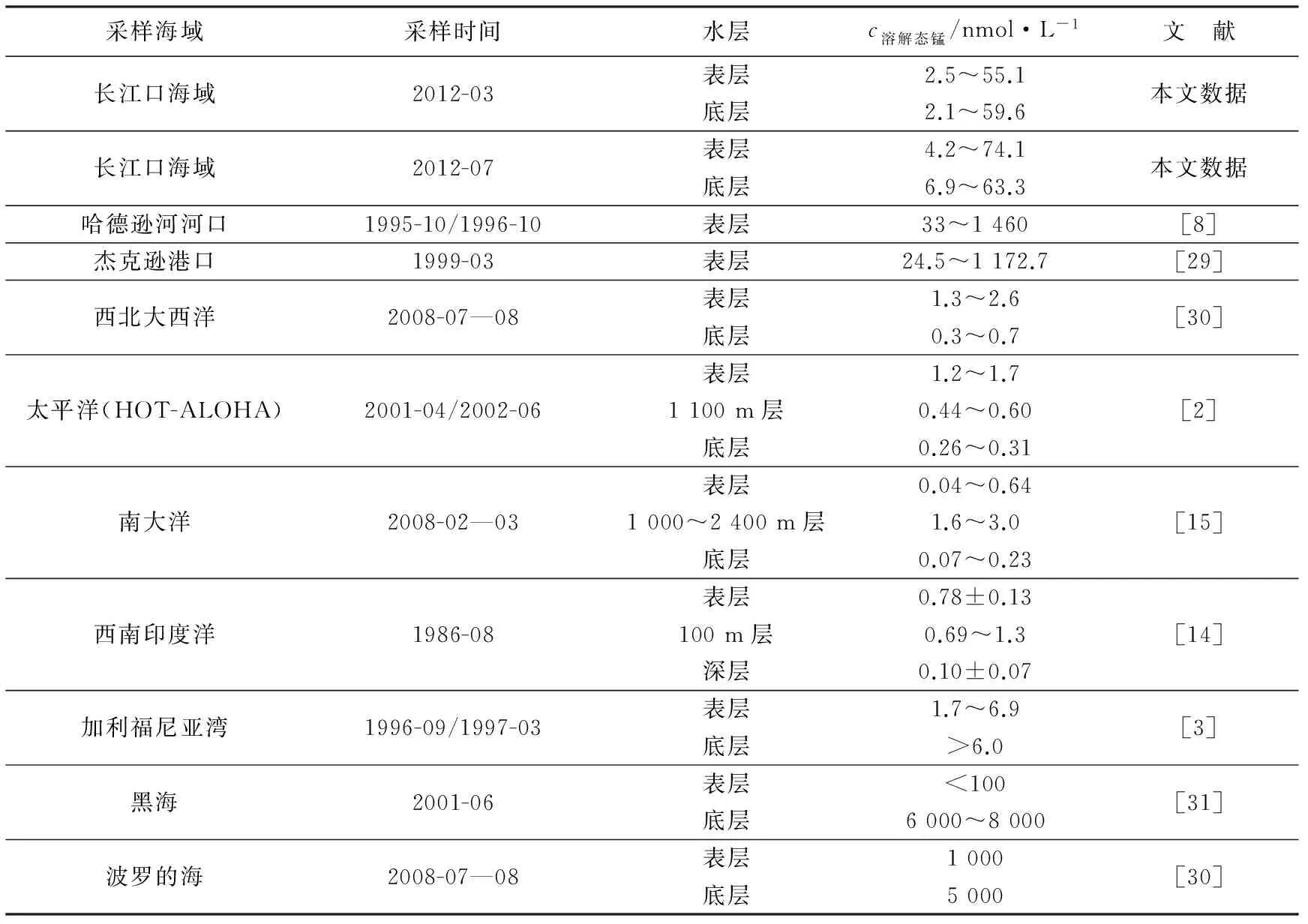
表2 世界主要大洋、海湾及河口中溶解态锰的浓度(nmol·L-1)

图2 2012-03 Niskin和飞鱼采水器采集的9个相同站位溶解态锰浓度对比Fig.2 Comparison of dissolved manganese concentrations collected at 9 same stations by Niskin and towed fish system in March 2012
为检验CTD自带的Niskin采水器是否存在对痕量元素溶解态锰的样品产生沾污,2012-03在15个站位现场利用国际通用的表层水体痕量元素采集方法——飞鱼采水器(采水器结构参照Vink等[32])采集表层样品,并在9个相同站位用Niskin采水器进行采样。对比2种采水器采集的表层样品中溶解态锰浓度(图2)发现,两者之间不存在显著性差异(t检验,置信度为95%),说明研究区域内CTD自带的Niskin采水器对溶解态锰样品不存在明显的沾污。
2012-03和2012-07长江口及邻近海域表、底层海水温度、盐度、SPM质量浓度以及溶解态锰浓度的分布见图3和图4。2012-03表、底层海水温度均呈现出近岸低外海高,南高北低的分布特点;2012-07表层海水温度由近岸向外海呈现出先降低后升高的分布趋势,底层温度由北向南逐渐降低。受长江冲淡水及外海水团入侵的影响,2个航次中表、底层盐度分布规律大致相似,均呈现出由长江口向外海逐渐升高的趋势。若以31等盐度线作为长江冲淡水影响的外源边界[33],长江冲淡水对表层的影响高于底层,且2012-07向东扩展得更远,最远可至124°30′E。把34等盐线作为高盐水入侵的主体边界,可以看出在研究区域的东南方向存在着高温高盐的水团,向近岸方向入侵,这种现象在底层更为明显,且2012-07最远侵入到122°30′E。SPM的质量浓度由近岸向外海逐渐降低,但在长江口口门处有一定程度的增加,最高质量浓度出现在2012-07的Y6站位附近(表、底层海水中SPM质量浓度分别达到289.8 mg·L-1和786.6 mg·L-1),应该是受到底层沉积物再悬浮的影响。
长江口及邻近海域水体中表、底层溶解态锰的分布特征均呈现出由近岸到外海逐渐降低的趋势,且表层浓度比底层浓度降低得更快,说明长江冲淡水、浙闽沿岸流等陆源输入对锰的分布有一定的影响。2个航次表、底层溶解态锰浓度均在长江口口门附近出现高值,与SPM质量浓度高值区(Y5站位附近)位置基本一致,说明底层沉积物的释放对锰分布的影响不容忽视。
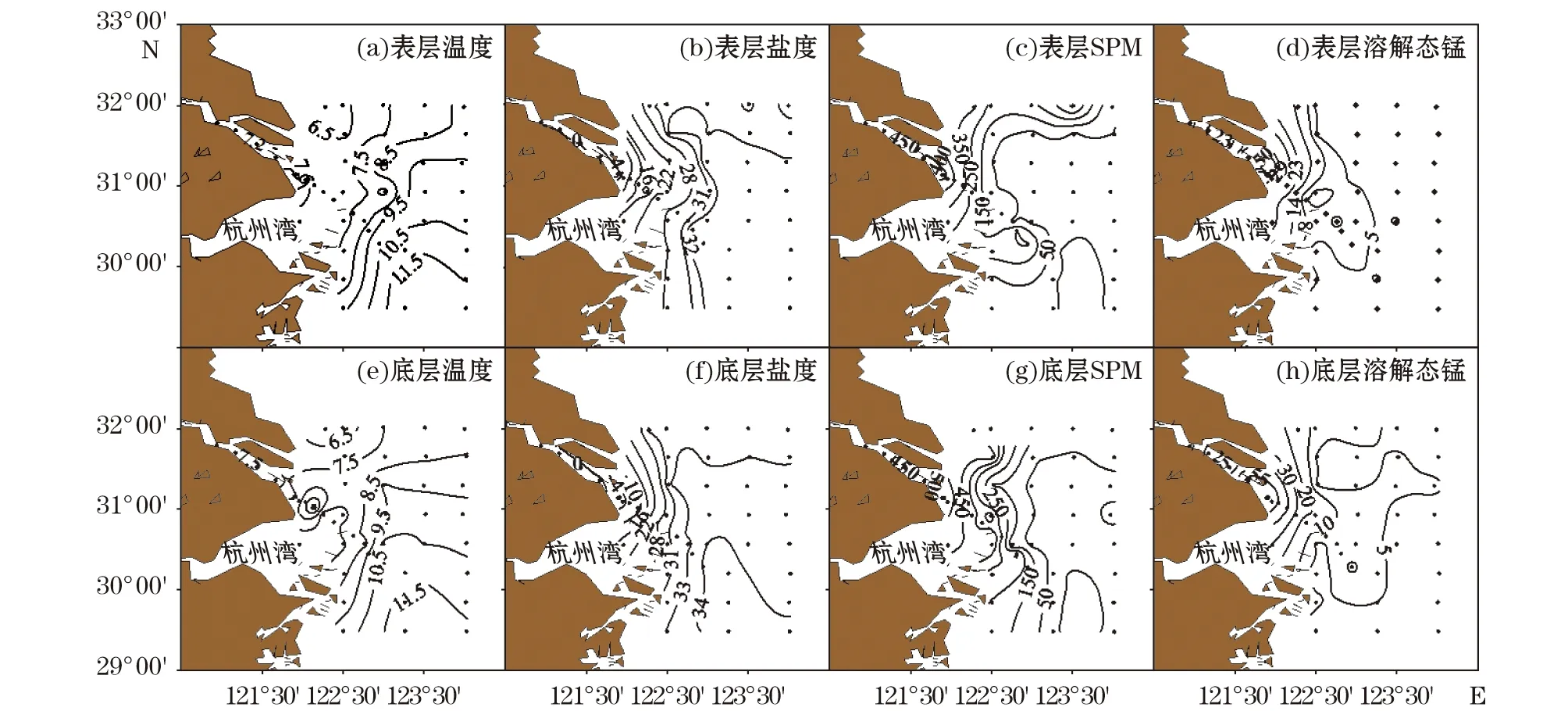
图3 2012-03长江口及其邻近海域表、底层温度(℃)、盐度、SPM质量浓度(mg·L-1)及溶解态锰浓度(nmol·L-1)的水平分布Fig.3 Horizontal distributions of temperature(℃), salinity, SPM(mg·L-1)and dissolved manganese concentrations(nmol·L-1) in surface and bottom waters of the Changjiang Estuary and its adjacent area in March 2012
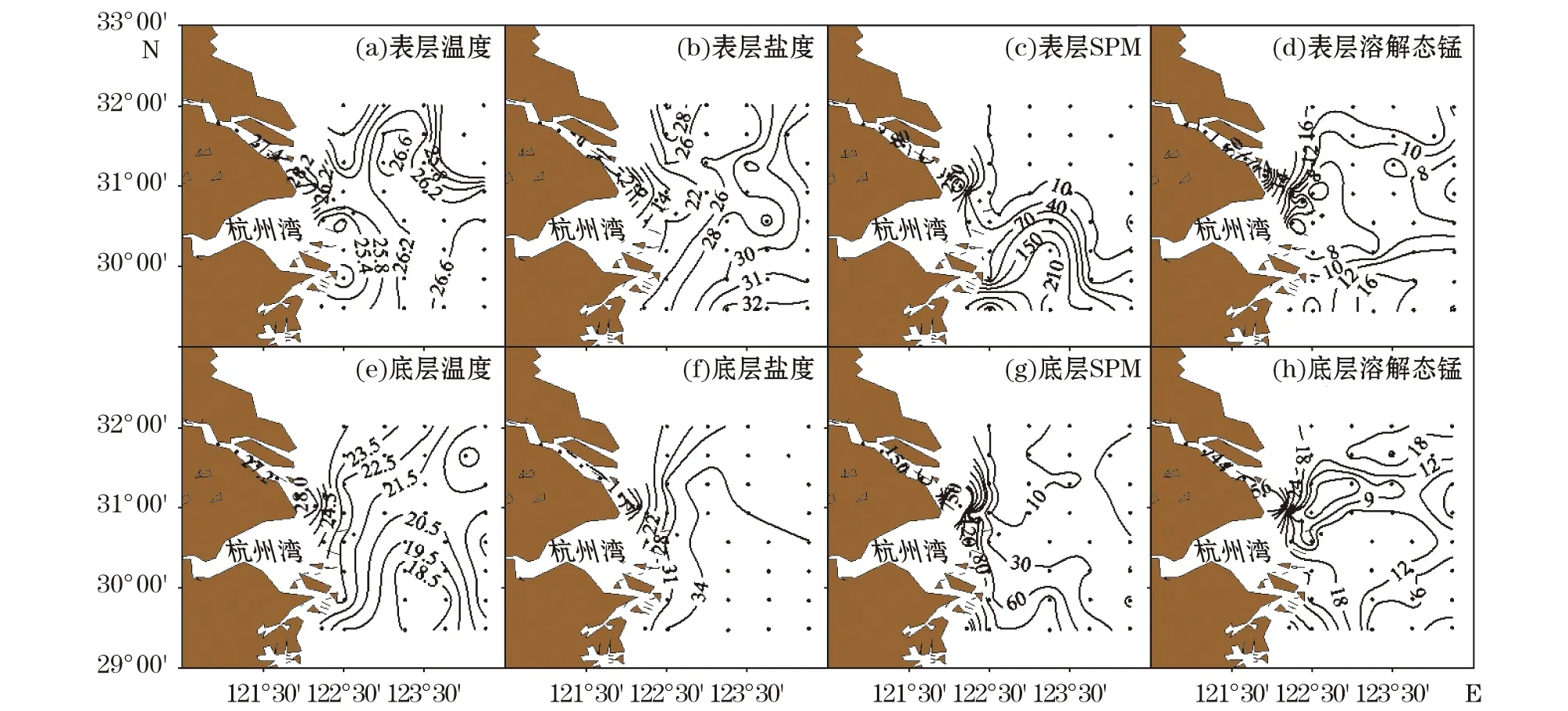
图4 2012-07长江口及其邻近海域表、底层温度(℃)、盐度、SPM质量浓度(mg·L-1)及溶解态锰浓度(nmol·L-1)的水平分布Fig.4 Horizontal distributions of temperature(℃), salinity, SPM(mg·L-1)and dissolved manganese concentrations(nmol·L-1) in surface and bottom waters of the Changjiang Estuary and its adjacent area in July 2012
2.2影响长江口及邻近海域溶解态锰分布的主要因素
2.2.1长江口及邻近海域溶解态锰的生物地球化学行为
河口及近岸海域盐度与溶解态锰浓度的相关关系体现了水团混合对溶解态锰分布产生的影响。2012-03和2012-07航次中长江口及其邻近海域的T-S点聚图(图5)显示,长江口及邻近海域存在多个水团,主要包括长江冲淡水(CDW)、台湾暖流(TCWW)、陆架混合水(SMW)以及黑潮次表层水(KSSW)等[34-36]。

图5 2012-03及2012-07长江口及邻近海域T-S点聚图Fig.5 Plot of Temperature-Salinity in the Changjiang Estuary and its adjacent area in March and July 2012
2012-03和2012-07入侵该研究区域的高盐水分别来自东海南部陆架区的台湾暖流和黑潮次表层水。由于2012-03长江河道内采集的站位盐度均为0,一直到口门附近的Y4站位,故选取口门附近的Y4站位作为2012-03零盐度临界站位,同样的方法选出2012-07零盐度站位Y5。如果仅考虑水团物理混合,把49.5 nmol·L-1(2012-03零盐度临界站位浓度)和7.6 nmol·L-1(2011-05台湾海峡区样品平均浓度,实验室未发表数据)分别作为2012-03长江冲淡水和台湾暖流端元的溶解态锰浓度[37-39],其连线即为理论稀释线,同样的方法选出7月份的端元浓度(表3)。

表3 2012-03和2012-07长江口及邻近海域盐度和溶解态锰浓度的端元值
注:*为2012-07盐度0临界站位浓度;
**为2011-05黑潮样品平均浓度(实验室未发表数据),可代表2012-07数据
2012-03和2012-07航次长江口及其邻近海域溶解态锰浓度与盐度的关系图(图6,距离为以长江下游盐度为0的边界站位为零点,沿长江口河道向上游延伸的距离为负值;TCL为理论稀释线)显示,长江口河道内表层溶解态锰浓度出现先降低后升高的现象,这可能受到不同陆源输入的影响。长江口口门以外海域,2012-03溶解态锰浓度与盐度的相关关系(c=-1.283 8S+46.504,r2=0.825 9)与理论稀释线较吻合,说明2012-03长江口及其邻近海域溶解态锰基本表现为保守混合。2012-07表层溶解态锰浓度在盐度5~20海域明显低于理论稀释线,在盐度2~8的海域范围内,溶解态锰浓度迅速下降,而盐度大于8的海域范围溶解态锰浓度基本稳定,说明表层溶解态锰浓度在盐度2~8的海域发生了明显的清除。

图6 2012-03和2012-07长江口及邻近海域表、底层溶解态锰浓度与盐度的关系Fig.6 The relationships between dissolved manganese concentrations and salinity in surface and bottom waters of the Changjiang Estuary and its adjacent area in March and July 2012
如果仅考虑水团的物理混合,已知2个水团(2012-03和2012-07)端元盐度与溶解态锰浓度(表3),根据计算公式Sa=xSCDW+ySTCWW和x+y=1分别计算出长江冲淡水和台湾暖流在水团混合过程中所占的比例x和y,其中Sa为实测盐度。再根据公式ce(Mn2+)=xcCDW(Mn2+)+ycTCWW(Mn2+),估算出该研究区域溶解态锰的浓度,结果见图7(Δc=ca-ce)。与实际观测结果相比,估算结果与溶解态锰浓度的实测结果分布规律基本吻合,均呈现出近岸浓度较高,随着离岸距离的增加浓度逐渐降低的趋势,但也存在较明显的差异。2012-03在长江口口门处估算值偏低于实测值,外海区域估算值偏高于实测值。2012-07底层在研究区域的东南方向及长江口口门处估算值偏低于实测值,表层的中间区域估算值高于实测值。这说明该海域溶解态锰浓度的分布并不仅仅只受到水团混合的影响,还可能受到其他因素的影响。
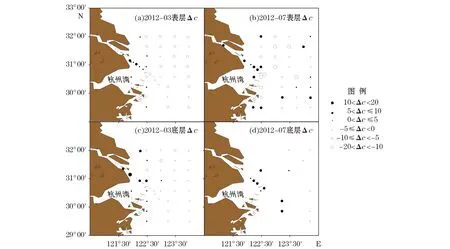
图7 2012-03和2012-07长江口及邻近海域溶解态锰浓度(nmol·L-1)的估算结果与实际结果比较Fig.7 Comparison of the theoretical and observed values of the dissolved manganese concentrations(nmol·L-1) in the Changjiang Estuary and its adjacent area in March and July 2012
2.2.2悬浮颗粒物对长江口溶解态锰浓度分布的影响
水体中悬浮颗粒物-水界面的吸附解吸对溶解态锰的分布有重要的影响[40]。2012-03和2012-07表、底层水体中溶解态锰浓度的估算相对偏差(ca(Mn2+)-ce(Mn2+))/ca(Mn2+)与SPM质量浓度之间的关系见图8,其中ca(Mn2+)为实测溶解态锰浓度,ce(Mn2+)为估算溶解态锰浓度。2012-03和2012-07表、底层溶解态锰浓度的估算相对偏差大都在0以下,说明SPM是溶解态锰的一个汇。估算相对偏差大于0的点集中在底层,且长江口口门处SPM在底层也出现了不同程度的增加(图3和图4),说明可能受到底层沉积物再悬浮的影响。对长江口邻近海域沉积物粒度的研究表明,SPM质量浓度和溶解态锰浓度出现高值的区域都处在前三角洲区(长江口最大浑浊带区域)[41],其泥沙主要来源于长江口外泄的高质量浓度悬沙,沉积物以粘土质粉砂为主,颗粒较细,水体中悬浮颗粒物质量浓度较高[42]。长江口上游来的微量元素不同程度地被截留在最大浑浊带,其中Fe,Mn和Pb最高[43],此外最大浑浊带通常伴随着较强的底层沉积物再悬浮现象,底层沉积物的再悬浮更有利于溶解态锰的释放。另外沉积物-水界面溶解态锰向上覆水的释放通量约为420~2 600 μmol·(m2·d)-1[44-45],上覆水中高浓度的溶解态锰,通过与底层水体的迁移、交换等作用,使底层溶解态锰出现局部高值,故底层实测值高于估测值,可能是由于沉积物的释放或再悬浮引起。

图8 2012-03和2012-07表、底层溶解态锰浓度的估算偏差与SPM质量浓度(mg·L-1)的关系Fig.8 Correlations between estimated relative deviations of dissolved manganese concentrations and SPM(mg·L-1) in surface and bottom waters in March and July 2012
3结论
通过对2012-03和2012-07长江口及邻近海域溶解态锰浓度分布及其影响因素的分析,得出3个结论:
1)2012-03和2012-07长江口及其邻近海域海水中表、底层溶解态锰浓度均呈现出近岸浓度高,随着离岸距离的增加浓度逐渐降低的分布趋势;
2)长江口及其邻近海域海水中溶解态锰浓度存在明显的季节变化,2012-07(夏季)显著高于2012-03(春季)。2012-03表、底层浓度没有显著性差异,而2012-07底层浓度显著高于表层(t检验,置信度为95%);
3)2012-03溶解态锰基本表现为保守混合,2012-07在盐度2~8的海域内表层发生了明显的清除。通过两端元混合模型及相关性分析发现,该海域悬浮颗粒物(SPM)是溶解态锰的汇,水团混合是影响溶解态锰分布的重要因素。颗粒物的吸附解吸和浮游植物生长对锰生物地球化学循环的影响机制是进一步深入研究的主要方向。
致谢:华东师范大学朱建荣教授提供温度、盐度数据。
参考文献(References):
[1]WEDEPOHL H K. The composition of the continental crust[J]. Geochimica et Cosmochimica Acta, 1995, 59(7): 1217-1232.
[2]BOYLE E A, BERGQUIST B A, KAYSER R A, et al. Iron, manganese, and lead at Hawaii Ocean Time-series station ALOHA: Temporal variability and an intermediate water hydrothermal plume[J]. Geochimica et Cosmochimica Acta, 2005, 69(4): 933-952.
[3]DELGADILLO-HINOJOSA F, SEGOVIA-ZAVALA J A, HUERTA-DAZ M A, et al. Influence of geochemical and physical processes on the vertical distribution of manganese in Gulf of California waters[J]. Deep Sea Research Part I: Oceanographic Research Papers, 2006, 53(8): 1301-1319.
[4]LEWIS B L, LUTHER III G W. Processes controlling the distribution and cycling of manganese in the oxygen minimum zone of the Arabian Sea[J]. Deep Sea Research Part II: Topical Studies in Oceanography, 2000, 47(7): 1541-1561.
[5]MORRIS A W, BALE A J. Effect of rapid precipitation of dissolved Mn in river water on estuarine Mn distributions[J]. Nature, 1979, 279(5711):318-319.
[6]MULLER F L L, TRANTER M, BALLS P W. Distribution and transport of chemical constituents in the Clyde Estuary[J]. Estuarine Coastal & Shelf Science, 1994, 39(2):105-126.
[7]KNOX S, TURNER D R, DICKSON A G, et al. Statistical analysis of estuarine profiles: application to manganese and ammonium in the Tamar Estuary[J]. Estuarine Coastal & Shelf Science, 1981, 13(4):357-371.
[9]COLBERT D, MCMANUS J. Importance of seasonal variability and coastal processes on estuarine manganese and barium cycling in a Pacific Northwest estuary[J]. Continental Shelf Research, 2005, 25(11):1395-1414.
[10]YAN L, STALLARD R F, KEY R M, et al. The chemical behavior of trace metals and226Ra during estuarine mixing in the Mullica River estuary, New Jersey, U.S.A.: A comparison between field observation and equilibrium calculation[J]. Chemical Geology, 1990, 85:369-381.
[11]BRULAND K W, DONAT J R, HUTCHINS D A. Interactive influences of bioactive trace metals on biological production in oceanic waters[J]. Limnology and Oceanography, 1991, 36(8): 1555-1577.
[12]WANG B L. The interaction between microalgae and trace metals in plateau lakes and the simulating experiment[D]. Beijing: The University of Chinese Academy of Sciences, 2005. 王宝利. 高原湖泊微藻和微量金属元素的相互作用过程及实验模拟研究[D]. 北京:中国科学院研究生院, 2005.
[13]WEI C L, WONG G T F, SUN S J, et al. Extractable manganese in the southeastern East China Sea shelf and the Okinawa Trough[J]. Oceanologica Acta, 2001, 24:99-111.
[14]MORLEY N H, STATHAM P J, BURTON J D. Dissolved trace metals in the southwestern Indian Ocean[J]. Deep Sea Research Part I: Oceanographic Research Papers, 1993, 40(5): 1043-1062.
[15]MIDDAG R, DE BAAR H J W, LAAN P, et al. Dissolved manganese in the Atlantic sector of the Southern Ocean[J]. Deep Sea Research Part II: Topical Studies in Oceanography, 2011, 58(25): 2661-2677.
[16]SHILLER A M. Manganese in surface waters of the Atlantic Ocean[J]. Geophysical Research Letters, 1997, 24(12): 1495-1498.
[17]WEGORZEWSKI A V, KUHN T. The influence of suboxic diagenesis on the formation of manganese nodules in the Clarion Clipperton nodule belt of the Pacific Ocean[J]. Marine Geology, 2014, 357: 123-138.
[18]YANG S Y, LI C X. Characteristic element compositions of the Yangtze and the Yellow River sediments and the geological background[J]. Marine Geology and Quaternary Geology, 1999, 19(2): 19-25.杨守业, 李从先. 长江与黄河沉积物元素组成及地质背景[J]. 海洋地质与第四纪地质,1999, 19(2): 19-25.
[19]CHE Y, HE Q, LIN W Q. The distributions of particulate heavy metals and its indication to the transfer of sediments in the Changjiang Estuary and Hangzhou Bay, China[J]. Marine Pollution Bulletin, 2003, 46(1): 123-131.
[20]HUANG P, LI T G, LI A C, et al. Distribution, enrichment and sources of heavy metals in surface sediments of the North Yellow Sea[J]. Continental Shelf Research, 2014, 73(2):1-13.
[21]ZHANG R, ZHANG J, REN J, et al. X-Vane: A sampling assembly combining a Niskin-X bottle and titanium frame vane for trace metal analysis of sea water[J]. Marine Chemistry, 2015, 177:653-661.
[22]REN J, XUAN J, WANG Z, et al. Cross-shelf transport of terrestrial Al enhanced by the transition of northeasterly to southwesterly monsoon wind over the East China Sea[J]. Journal of Geophysical Research Oceans, 2015, 120(7):5054-5073.
[23]LI L, REN J L, YAN Z, et al. Behavior of arsenic in the coastal area of the Changjiang (Yangtze River) Estuary: Influences of water mass mixing, the spring bloom and hypoxia[J]. Continental Shelf Research, 2014, 80(2):67-78.
[24]CUTTER G, ANDERSON P, CODISPOTI L, et al. Sampling and sample-handling protocols for GEOTRACES cruises[R/OL]∥(2010-12-09)[2015-09-22].http:∥www.geotraces.org/library-88/geotraces-policies/170-sampling-and-sample-handling-protocols-for-geotraces-cruises10.
[25]WANG Z W, REN J L, LIU S M. Determination method of dissolved manganese in natural water by catalytic kinetic spectrophotometry[J]. Marine Environmental Science, 2016, 35(1):137-143. 王召伟, 任景玲, 刘素美. 催化动力学分光光度法直接测定天然水体中痕量锰[J].海洋环境科学, 2016, 35(1):137-143.
[26]GUO Z H, HU X Y, WU Z, et al. Direct determination of manganese in seawater by leucomalachite green-sodium periodate catalytic kinetic spectrophotometry[J]. Journal of Xiamen University (Natural Science), 2009, 48(2):255-259. 郭洲华, 胡馨月, 吴镇,等. 隐色孔雀绿-高碘酸钠动力学光度法直接测定海水中的锰[J]. 厦门大学学报(自然科学版), 2009, 48(2):255-259.
[27]TREFRY J H, PRESLEY B J. Manganese fluxes from Mississippi Delta sediments[J]. Geochimica et Cosmochimica Acta, 1982, 46(10):1715-1726.
[28]GLASBY G P, SCHULZ H D. Eh pH diagrams for Mn, Fe, Co, Ni, Cu and as under seawater conditions: application of two new types of eh pH diagrams to the study of specific problems in marine geochemistry[J]. Aquatic Geochemistry, 1999, 5(3): 227-248.
[29]HATJE V, APTE S C, HALES L T, et al. Dissolved trace metal distributions in Port Jackson estuary (Sydney Harbour), Australia[J]. Marine Pollution Bulletin, 2003, 46(6): 719-730.
[30]YAKUSHEV E, PAKHOMOVA S, SΦRENSON K, et al. Importance of the different manganese species in the formation of water column redox zones: observations and modeling[J]. Marine Chemistry, 2009, 117(1): 59-70.
[31]YEMENICIOGLU S, ERDOGAN S, TUGRUL S. Distribution of dissolved forms of iron and manganese in the Black Sea[J]. Deep Sea Research Part II: Topical Studies in Oceanography, 2006, 53(17): 1842-1855.
[32]VINK S, BOYLE E A, MEASURES C I, et al. Automated high resolution determination of the trace elements iron and aluminium in the surface ocean using a towed fish coupled to flow injection analysis[J]. Deep Sea Research Part I: Oceanographic Research Papers, 2000, 47(6):1141-1156.
[33]GU G C, HU F X, HU H, et al. An analysis of high-concentration-salt water intrusion outside the Changjiang Estuary[J]. Donghai Marine Science, 1994, 12(3): 1-11. 谷国传, 胡方西, 胡辉, 等. 长江口外高盐水入侵分析[J]. 东海海洋, 1994, 12(3): 1-11.
[34]ZHANG J, LIU S M, REN J L, et al. Nutrient gradients from the eutrophic Changjiang (Yangtze River) Estuary to the oligotrophic Kuroshio waters and re-evaluation of budgets for the East China Sea Shelf[J]. Progress in Oceanography, 2007, 74(4): 449-478.
[35]LI W, WANG Y H, WANG J N, et al. Distributions of water masses and hydrographic structures in the Yellow Sea and East China Sea in spring and summer 2011[J]. Oceanologia et Limnologia Sinica, 2012, 43(3): 615-623. 李伟, 王玉衡, 汪嘉宁, 等. 2011 年春, 夏季黄, 东海水团与水文结构分布特征[J]. 海洋与湖沼, 2012, 43(3): 615-623.
[36]QI J F. The study on the water masses, Kuroshio and water exchange in the East China Sea[D]. Beijing: The University of Chinese Academy of Sciences, 2014. 齐继峰. 东海水团特征及黑潮与东海陆架水交换研究[D].北京: 中国科学院大学, 2014.
[37]REN J L, ZHANG G L, ZHANG J, et al. Distribution of dissolved aluminum in the Southern Yellow Sea: Influences of a dust storm and the spring bloom[J].Marine Chemistry, 2011, 125(1): 69-81.
[38]LI F M, REN J L, ZHANG G L, et al. The distribution of dissolved aluminum in the coastal area of Zhejiang and Fujian[J]. Acta Oceanlogica Sinica, 2012, 34(2): 63-72. 李发明, 任景玲, 张国玲,等. 闽浙沿岸海域溶解态铝的分布及其影响因素[J].海洋学报(中文版), 2012, 34(2): 63-72.
[39]LI L, REN J L, YAN Z, et al. Behavior of arsenic in the coastal area of the Changjiang (Yangtze River) Estuary: Influences of water mass mixing, the spring bloom and hypoxia[J].Continental Shelf Research, 2014, 80(2): 67-78.
[40]REN J L, ZHANG G L, LIU S M, et al. Review on the study of biogeochemical cycle of manganese in the oceans[J]. Advances in Marine Sciences, 2012, 30(3): 432-440. 任景玲, 张桂玲, 刘素美, 等. 海洋中锰的生物地球化学循环研究[J]. 海洋科学进展,2012, 30(3): 432-440.
[41]DOU Y G. Characteristics of sediment granularity, element geochemistry and their significance for identifying sedimentary environment in the contiguous sea areas of Changjiang River Estuary[J]. Qingdao: The First Institute of Oceanography, State Oceanic Administration, 2007. 窦衍光. 长江口邻近海域沉积物粒度和元素地球化学特征及其对沉积环境的指示[D]. 青岛: 国家海洋局第一海洋研究所, 2007.
[42]LI J F, ZHANG C. Sediment resuspension and implications for turbidity maximum in the Changjiang Estuary[J]. Marine Geology, 1998, 148(3): 117-124.
[43]SHEN H T. The new understanding of the research on the turbidity maximum of the estuary in China[J]. Advance in Earth Sciences, 1995, 10(2): 210-212. 沈焕庭. 我国河口最大浑浊带研究的新认识[J]. 地球科学进展, 1995, 10(2): 210-212.
[44]LASLETT R E, BALLS P W, LASLETT R E, et al. The behaviour of dissolved Mn, Ni and Zn in the forth, an industrialised, partially mixed estuary[J]. Marine Chemistry, 1995, 48(3-4):311-328.
[45]WARNKEN K W, GILL G A, GRIFFIN L L, et al. Sediment-water exchange of Mn, Fe, Ni and Zn in Galveston Bay, Texas[J]. Marine Chemistry, 2001, 73(3-4):215-231.
Received: September 22, 2015
*收稿日期:2015-09-22
作者简介:杨亭亭(1990-),女,山东菏泽人,硕士研究生,主要从事痕量元素的海洋生物地球化学方面研究.E-mail:yangting0708@163.com *通讯作者:任景玲(1973-),女,天津人,教授,博士,硕士生导师,主要从事海洋生物地球化学方面研究.E-mail:renjingl@ouc.edu.cn(高峻编辑)
中图分类号:P734.4
文献标识码:A
文章编号:1671-6647(2016)02-0260-11
doi:10.3969/j.issn.1671-6647.2016.02.011
Distributions and Influence Factors of Dissolved Manganese in the Changjiang Estuary and Its Adjacent Area
YANG Ting-ting1,2, REN Jing-ling1,2, WANG Zhao-wei1,2, ZHANG Xu-zhou1,2, ZHANG Rui-feng3,4
(1.OceanUniversityofChina, Qingdao 266100, China;2.KeyLaboratoryofMarineChemistryTheoryandTechnology,MinistryofEducation, Qingdao 266100, China;3.EastChinaNormalUniversity,Shanghai 200062, China;4.StateKeyLaboratoryofEstuarineandCoastalResearch,Shanghai 200062,China)
Abstract:2 cruises were carried out in March and July 2012 in the Changjiang Estuary and its adjacent area in order to study the biogeochemical cycle of manganese in marginal seas. The concentrations of dissolved manganese were measured by Leucomalachite Green-sodium Periodate Catalytic Kinetic Spectrophotometry. There were no significant difference between the concentrations of dissolved manganese in the surface and bottom waters in March 2012. While in July, the concentrations in the bottom were obviously higher than that in the surface. There were significant seasonal variations between the two cruises, with the higher average concentrations in July than in March. The concentrations of dissolved manganese in both surface and bottom waters decreased from the coastal area to the shelf region during the 2 cruises, with high concentrations occurred in the Changjiang Estuary, suggesting that it was affected by the river input. The behavior of dissolved manganese in the Changjiang Estuary and its adjacent area was mainly conservative in March. On the contrary, it was significantly scavenged from surface waters where the salinity ranged from 2 to 8 in July. SPM was the primary sink of dissolved manganese in this area by the 2 end-members mixing model and correlation analysis. In addition, Water masses mixing was the main factor affecting the concentrations and distributions of dissolved manganese in the study area.
Key words:Changjiang Estuary and its adjacent area; dissolved manganese; distributions; seasonal variations; influencing factors
资助项目:国家自然科学基金项目——长江口及东海溶解态锰的分布、形态转化及其影响机制(41176096);国家基础研究发展计划项目——多重压力下近海生态系统的可持续产出与适应性管理的科学基础(2011CB409801);科技部国际科技合作专项——波罗的海和东海的低氧的对比研究:以气候变化和土地利用改变为因素(2010DFA24590)

